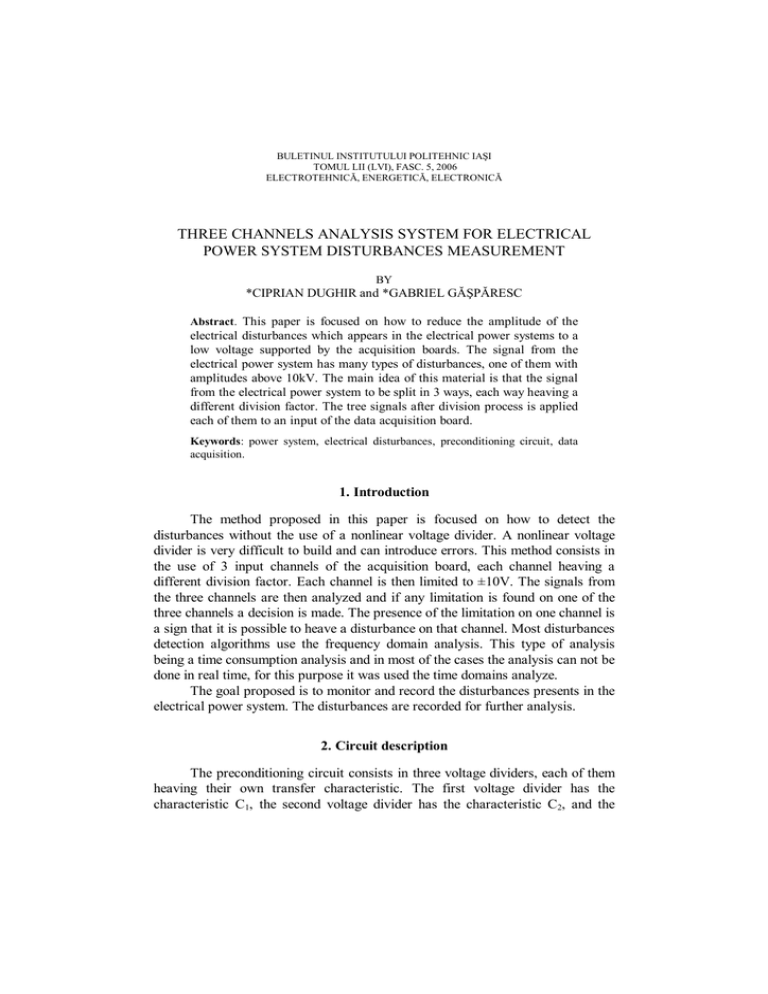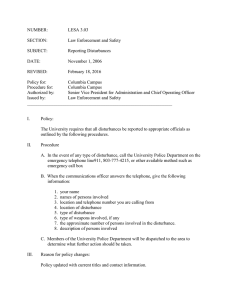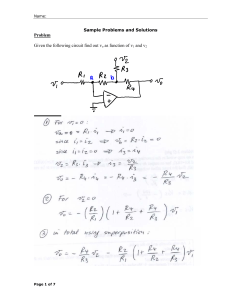three channels analysis system for electrical power system
advertisement

BULETINUL INSTITUTULUI POLITEHNIC IAŞI TOMUL LII (LVI), FASC. 5, 2006 ELECTROTEHNICĂ, ENERGETICĂ, ELECTRONICĂ THREE CHANNELS ANALYSIS SYSTEM FOR ELECTRICAL POWER SYSTEM DISTURBANCES MEASUREMENT BY *CIPRIAN DUGHIR and *GABRIEL GĂŞPĂRESC Abstract. This paper is focused on how to reduce the amplitude of the electrical disturbances which appears in the electrical power systems to a low voltage supported by the acquisition boards. The signal from the electrical power system has many types of disturbances, one of them with amplitudes above 10kV. The main idea of this material is that the signal from the electrical power system to be split in 3 ways, each way heaving a different division factor. The tree signals after division process is applied each of them to an input of the data acquisition board. Keywords: power system, electrical disturbances, preconditioning circuit, data acquisition. 1. Introduction The method proposed in this paper is focused on how to detect the disturbances without the use of a nonlinear voltage divider. A nonlinear voltage divider is very difficult to build and can introduce errors. This method consists in the use of 3 input channels of the acquisition board, each channel heaving a different division factor. Each channel is then limited to ±10V. The signals from the three channels are then analyzed and if any limitation is found on one of the three channels a decision is made. The presence of the limitation on one channel is a sign that it is possible to heave a disturbance on that channel. Most disturbances detection algorithms use the frequency domain analysis. This type of analysis being a time consumption analysis and in most of the cases the analysis can not be done in real time, for this purpose it was used the time domains analyze. The goal proposed is to monitor and record the disturbances presents in the electrical power system. The disturbances are recorded for further analysis. 2. Circuit description The preconditioning circuit consists in three voltage dividers, each of them heaving their own transfer characteristic. The first voltage divider has the characteristic C1, the second voltage divider has the characteristic C2, and the CIPRIAN DUGHIR and GABRIEL GĂŞPĂRESC third voltage divider has the characteristic C3, described in the figure 2. The signals from the voltage dividers are then applied to an acquisition board and analyzed. For the acquisition of the signal it was used the National Instruments acquisition board NI PCI 6254M with a sample rate of 250Ksample/sec on each channel. Voltage divider 1/50 ratio CH1 Voltage divider 1/200 ratio Electrical power system network CH2 Voltage divider 1/1000 ratio CH3 A c q u i s it i o n B o a r d Fig. 1.- Preconditioning circuit diagram. If any disturbance is found in the first channel, the signal is tested to see if the signal was limited or not. In the signal was not limited, the disturbance has the amplitude smaller than 500V. If a limitation is found, the second channel is tested for a limitation, using the same procedure as for the first channel. If no limitation has been found, the disturbances have the amplitude smaller than 2kV. The same procedure is applied for the third channel if the signal of the second channel was limited. Uout C1 C2 10V C3 500V 2000V 10000V Fig. 2.- Transfer function of the voltage dividers. Uin BUL. INST. POLIT. IAŞI, TOMUL LII (LVI), FASC. 5 In the figure 3, is presented a signal with a spike disturbance with amplitude about 9kV, split in three channels using the method proposed and then applied to the data acquisition board. In the first and second channel it can be observed a limitation of the signal. In the third channel, no limitation can be found, so the signal from the third channel can be recorded for further analysis. UCH1 10v t UCH2 10v t UCH3 10v t Fig. 3.- Spike disturbance over imposed to the signal. The algorithm of detecting the disturbances is presented in the figure 4. The first channel is always analyzed with the methods presented in [1] and [2]. If any disturbances are found, the samples for all three channels is analyzed and checked for limitation. If a limitation is found on any of the three channels, is then checked the channel with the lower amplitude and without limitation and this channel is then recorded. The goal is to record a signal with a maximum dynamic range. It’s not necessarily to save all three channels because if, for example, a disturbance with the amplitude higher than 10kV is applied at the input of the system, in all three channels can be found limitations of the signal. The signal which is more accurate and reflects the reality is the signal on the third channel. The most important disturbances in this case is the disturbance with higher amplitude because their high energy. In the first and second channel may or may not be found disturbances with smaller amplitudes. In special cases it is useful to record the signals from all three channels; this is the case in which among the high voltage spike can be found disturbance with small amplitude around 220V. For high accuracy analysis is recommended to record all three channels and analyze the signal later. CIPRIAN DUGHIR and GABRIEL GĂŞPĂRESC The system record the entire period of the signal in which is fond the disturbances. This method of signal preconditioning and analysis can be used alone for detecting the singular and symmetrical disturbances in the electrical power system with the amplitude over 500V. The method is simple: the signal from the first channel is analyzed, and if any disturbances with the amplitude over 500V are over imposed to the signal, then a limitation appears on the first channel signal. Electrical power network Acquisition board Analyze one sample for each channel Channel 1 voltage limit? 3 Signal analysis algorithm 3 no yes Decision block Channel 2 voltage limit? no yes Channel 3 voltage limit? no Record signal yes Fig. 4.- Diagram of the algorithm for detecting and monitoring the disturbances. The presence of this limitation is an indication that a disturbance is present in this point. The algorithm is identical for the second and third channel. The presence of the limitation in the signal shape is always an indication of the presence of a disturbance. In this way all disturbances with amplitude higher than 500V can be easily detected. The decision block presented in figure 4 can classify the disturbance depending on their amplitude. BUL. INST. POLIT. IAŞI, TOMUL LII (LVI), FASC. 5 3. Software application The software application is written using Microsoft Visual C++ 6. The main window of the application contains three plots (in the left of the window) which display on-line the three channels of signal. The signal captured presents a disturbance with amplitude of 2.5kV. The first and the second channel present a limitation in their maximum amplitude. In the upper right corner of the window is displayed a period of the signal with the last disturbance found in the first channel to be easily visualized. This image is displayed until a new disturbance is found, and replaced with a new image. Fig. 5.- Main window of the software application for detection and monitoring the disturbances in the electrical power systems The second plot in the right part of the window is the regularity index. This index is a number representing the presence of a disturbance if his value is nonzero as is explained in [1], [2] and [3]. This plot is scrolling from right to left, this means that the last disturbance is displayed in the right of the plot, being a history of the apparition of disturbances. The circular plot in the bottom right corner of the window displays the status of the operations in the circular buffer [1]. The samples from the acquisition board are stored in the circular memory and then are analyzed. CIPRIAN DUGHIR and GABRIEL GĂŞPĂRESC 5. Conclusions The preconditioning circuit presented in this paper is very simple and low cost. The analysis method proposed in this paper can be used alone, or together with other methods of analyze, improving their performance. Using this method together with the method presented in [1], increase the accuracy of detecting the disturbances with amplitudes higher than 500V at 100%. In this case, the computing time increase with 10%, due to the supplementary calculations which are made. Appendix *“Politehnica” University, Department of Measurement and Optical Electronics, Electronics and Telecomunications, Timişoara, Romania; REFERENCES 1. Ciprian Dughir, Detecting symmetrical disturbances in electrical power systems, lucrările sesiunii ştiinţifice “Doctor Etc 2005”, Timişoara, September 22, 2005. 2. Traian Jurca, Ciprian Dughir, Monitorizarea perturbaţiilor din reţeaua de joasă tensiune, lucrările sesiunii ştiinţifice “Electroenergetica”, Sibiu, November 2004. 3. Marcello Artioli, Gaetano Pasini, Lorenzo Peretto, Renato Sasdelli, Fiorenzo Fillippetti, Low-Cost DSP-Based Equipment for the Real-Time Detection of Transients in Power Systems, IEEE Transactions on Instrumentation and Measurement vol. 53, no. 4, August 2004 4. Tarlochan S. Sidhu, Accurate Measurement of Power System Frequency Using a Digital Signal Processing Tehnique, IEEE Transactions on Instrumentation and Measurement vol. 48, no. 1, February 1999 5. Giovanni Bucci, Edoardo Fiorucci, Carmine Landi, Digital Measurement Station for Power Quality Analisys in Distributed Environments, IEEE Transactions on Instrumentation and Measurement vol. 52, no. 1, February 2003 6. A.Y. Zayezdny, I. Druckman, Short time measurement of frequency and amplitude in the presence of noise, IEEE Comput. Applicat Power, vol. 10, Apr. 1997 SISTEM DE ANALIZĂ PE TREI CANALE PENTRU MĂSURAREA PERTURBAŢIILOR DIN SISTEMELE DE DISTRIBUŢIE A ENERGIEI ELECTRICE (Rezumat) Se prezintă un sistem de detectare şi măsurare a perturbaţiilor din sistemele de distribuţie a energiei electrice ce utilizează un sistem de achiziţie de date pe trei canale şi un sistem de precondiţionare a semnalelor construit cu ajutorul a trei divizoare de tensiune cu diferite rapoarte de divizare. Sistemul propus poate fi utilizat şi pentru detectarea perturbaţiilor simetrice şi nesimetrice cu amplitudini mai mari de 500V ce apar în sistemele de distribuţie a energiei electrice.




